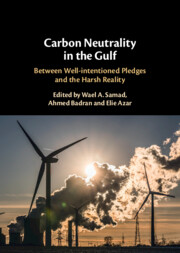Book contents
- Carbon Neutrality in the Gulf
- Carbon Neutrality in the Gulf
- Copyright page
- Contents
- Contributors
- Acknowledgments
- Abbreviations
- Part I Introduction
- Part II Circular Carbon Economy and Pathway Frameworks
- Part III Infrastructure
- Part IV Policy and Data Transparency
- 8 GCC Carbon Neutrality and Net Zero Policy Tracker
- 9 Data Policies and Governance for Greenhouse Gases Reports and Initiatives
- 10 Key Issues for Long-Term Climate Policy Design in GCC Countries with a Focus on Qatar
- Part V Behavioural Aspects and Human Factors
- Part VI Conclusion
- Index
- References
8 - GCC Carbon Neutrality and Net Zero Policy Tracker
Framing, Methodology, and Findings
from Part IV - Policy and Data Transparency
Published online by Cambridge University Press: 02 January 2025
- Carbon Neutrality in the Gulf
- Carbon Neutrality in the Gulf
- Copyright page
- Contents
- Contributors
- Acknowledgments
- Abbreviations
- Part I Introduction
- Part II Circular Carbon Economy and Pathway Frameworks
- Part III Infrastructure
- Part IV Policy and Data Transparency
- 8 GCC Carbon Neutrality and Net Zero Policy Tracker
- 9 Data Policies and Governance for Greenhouse Gases Reports and Initiatives
- 10 Key Issues for Long-Term Climate Policy Design in GCC Countries with a Focus on Qatar
- Part V Behavioural Aspects and Human Factors
- Part VI Conclusion
- Index
- References
Summary
This chapter focuses on the global decarbonisation policy gap and the need to account for measurable policies for carbon neutrality, specifically in the Gulf Cooperation Council (GCC) region. One strategy to raise accountability is policy tracking, a technique that has gained traction in empirical policy analysis. The chapter introduces this technique and provides an example of a methodologically rigorous tracking of climate policies in the GCC countries in response to pledges and obligations under the Paris Agreement. This includes government policies, laws, and measures toward the mitigation goals of the Paris Agreement and carbon neutrality targets. We situate our tracker in the wider landscape of policy metrics and indexes, discuss its features, and present results on mitigation and energy policy responses to the climate crisis in the Gulf. Key conclusions are that stringency, intensity, effectiveness, and sustainability of measures vary widely across the sample and over time. Necessary macroeconomic, fiscal, technological, and social policy measures also vary greatly in terms of their intensity and the public investments made. In some GCC countries, policy measures appear to be disproportionate to the challenges linked to both reaching the goals of the Paris Agreement and the Gulf countries’ very own nationally determined contributions (NDCs), to varying degrees.
Keywords
- Type
- Chapter
- Information
- Carbon Neutrality in the GulfBetween Well-intentioned Pledges and the Harsh Reality, pp. 153 - 175Publisher: Cambridge University PressPrint publication year: 2025

